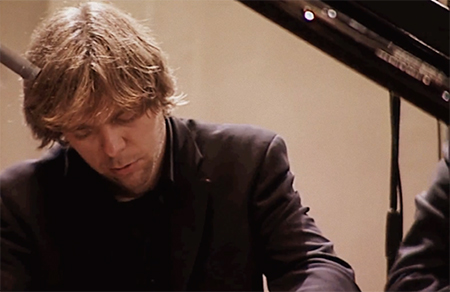by Timothy Robson

The intellectually and musically interesting program, which lasted about 75 minutes without intermission, was expertly performed by pianist Andrius Žlabys, flutist Irad Carmi, and clarinetist Franklin Cohen. Each performer got a solo opportunity, and all combined at the end for a dazzling trio by American composer Paul Schoenfeld. If there was any complaint to be made, the half-sheet that served as the printed program lacked the performers’ names and details about the works.
Carmi and Žlabys opened with Carl Philipp Emanuel Bach’s two-movement Sonata in G, Wq. 133, in a gracious and fluent performance that was perfect for this setting. The flute part was highly virtuosic, decorated with ornaments and intricate scalar passages. Žlabys was an excellent collaborator, although his part had little interest on its own, functioning more as a written-out basso continuo.
Henri Dutilleux’s Sonatine for flute and piano gave both performers much more to do. The sonatina is in several identifiable sections combined into one longer movement. There are hints of influences by others, especially Olivier Messiaen, although Dutilleux uses much more traditional tonality. The instruments are mostly equal partners, though the flute is given several cadenzas of great difficulty. Carmi played with a variety of tone, from brilliance in the upper register to great sensuousness in his lower range. The performers were precise in ensemble.
Francis Poulenc’s Sonata for Clarinet and Piano was commissioned by the great American clarinetist Benny Goodman. The premiere with Goodman and the composer was scheduled for January 1963, but Poulenc died unexpectedly, and the first performance was given later that year by Goodman and Leonard Bernstein. Filled with Poulenc’s whole bag of unique harmonic and melodic traits, it takes only a few measures to identify the composer. Its moods are mercurial. The second movement features dark, moody, spun-out melodies. The third is like a burlesque, often in a high, almost shrieking tessitura, although there are a few moments of repose before the comic conclusion. Cohen and Žlabys captured the many moods of the piece and were technically superb.

The prim title of the closing work, Paul Schoenfeld’s Sonatina for flute, clarinet and piano, belies its complexity and humor. The American composer, who won the 1994 Cleveland Arts Prize, has used three American dance styles (Charleston, Rag, and Jig) as the basis of a virtuosic chamber work. It is as if these three dances were deconstructed, reassembled with late-20th century musical techniques, and viewed through a surrealist haze. The rhythms are of the utmost complexity, as are the musical demands on the three performers. The Charleston begins with a slow introduction before the body of the work gets into full swing. The tonality wanders freely. A tune in the Jig sounded like it might have been a pre-existing sea shanty, but then, maybe not. In Schoenfeld’s musical house of funny mirrors, anything is possible. This performance was astonishing in its brilliance.
Published on ClevelandClassical.com May 20, 2019.
Click here for a printable copy of this article



